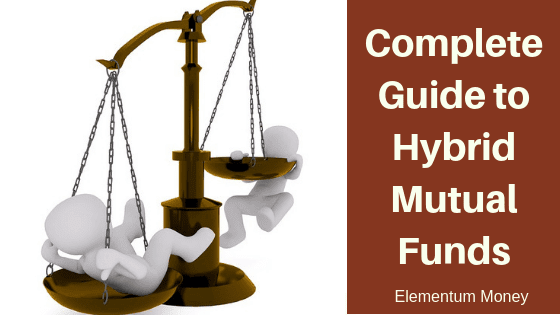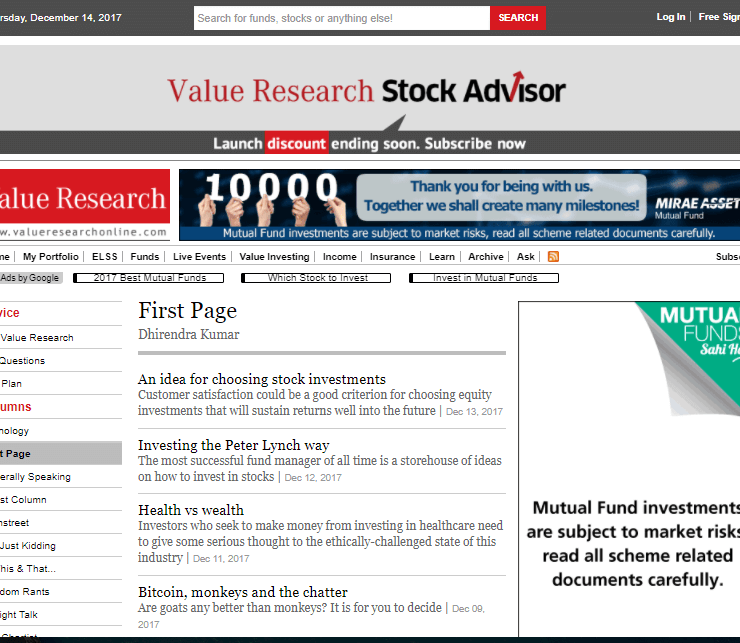One of my favorite financial assets remains Mutual Funds. Despite the turmoil in equity and debt markets and even with lower distribution commission meaning there is little incentive for a lot of independent distributors to peddle the product to the lay investor, Mutual Funds Abhi bhi sahi hai (Mutual funds are still the right choice). One of the best decisions that SEBI took last year was the clean lines of categorization that they drew across the earlier cluttered landscape. With the pre-defined 16 categories, one can clearly see the three broad classes of Equity, Debt and Hybrid Mutual funds. When I moved from Marketing to becoming a Wealth Specialist (yeah, I know the title is particularly fancy!), my understanding was up to the mark probably only for Equity funds. Yours truly is glad to report that she has been able to wing it for the first few months till the time she could be well versed with the Debt and Hybrid categories too. While I already wrote down what an investor must know about Debt Mutual Funds, I realized that I needed to extend this generosity to the Hybrid Mutual Funds too.
What are Hybrid Mutual Funds?
In Hybrid Mutual funds, there are 7 SEBI designated categories. As the name suggests, Hybrid funds come with in-built diversification. That means they come with lower risk as well as a lower return profile. Most of these funds play in two big asset classes – equity and debt, which have over the long term been inversely correlated. In years when equity zoomed, debt would perform dismally whereas in years when equity had the blues debt returns could help ease the gloom.
Taxation on Hybrid Mutual Funds
For Hybrid Mutual funds, any fund having an assets allocation of more than 65{76b947d7ef5b3424fa3b69da76ad2c33c34408872c6cc7893e56cc055d3cd886} in equities is considered as equity for the purpose of tax calculation. On the other hand, any hybrid mutual fund with more than 35{76b947d7ef5b3424fa3b69da76ad2c33c34408872c6cc7893e56cc055d3cd886} allocation to debt is considered as a debt investment.
This fact is of immense importance as debt and equity vary widely in their taxation rules, equity being far more favorable. Read this detailed post with examples for a better understanding of capital gains tax and it’s rules for both equity and debt.
1. Conservative Hybrid funds
Conservative hybrid funds are those which invest the majority of its assets, 75-90{76b947d7ef5b3424fa3b69da76ad2c33c34408872c6cc7893e56cc055d3cd886} in debt. The remaining 10-25{76b947d7ef5b3424fa3b69da76ad2c33c34408872c6cc7893e56cc055d3cd886} is invested in equity. These funds are suitable for investors who do not trust equity but would still like the psychological reassurance of having some skin in that game. This fund is also sometimes referred to as a Monthly Income Plan. Over a period of last 3 years, funds in this category have given a return of 6{76b947d7ef5b3424fa3b69da76ad2c33c34408872c6cc7893e56cc055d3cd886}-11.5{76b947d7ef5b3424fa3b69da76ad2c33c34408872c6cc7893e56cc055d3cd886} per annum.
Taxed as: Debt
3. Aggressive Hybrid
Aggressive Hybrid funds as the name suggests, are more into the aggressive asset of Equity. In some ways, this category is that of an equity fund with the risk slightly reduced by 20-35{76b947d7ef5b3424fa3b69da76ad2c33c34408872c6cc7893e56cc055d3cd886} diversification into debt. This fund works for people who like equity but would want some diversification to reduce the risk. Over the last 3 years, funds in the category have returned 8.3{76b947d7ef5b3424fa3b69da76ad2c33c34408872c6cc7893e56cc055d3cd886}-15.7{76b947d7ef5b3424fa3b69da76ad2c33c34408872c6cc7893e56cc055d3cd886}
AMCs are allowed to have either an Aggressive Hybrid fund or a Balanced fund. Since Aggressive hybrid fund gives the flexibility of investing in hedged equity and arbitrage opportunities as well as having the favourable taxation rule of equity, these funds are much more popular with far more options.
Taxed as: Equity
4. Dynamic Asset Allocation or Balanced Advantage
For quite some time, I couldn’t fathom what this category of the fund even meant. But, today it is one of my favorite categories, especially well suited to ride out volatility. Essentially, the fund consists of more than 65{76b947d7ef5b3424fa3b69da76ad2c33c34408872c6cc7893e56cc055d3cd886} equity and remaining debt. Within equity, some portion is hedged as a defense. The defining factor of the fund is regular rebalancing between the unhedged equity, hedged equity and debt on the basis of market indicators, with the basic indicator being PE of Price to Equity. In simpler terms, when the fund manager believes the market is undervalued, they buy more equity and when they believe the market is overvalued, they sell equity and increase their debt allocation. In effect, they are able to execute the maxim of “buy low, sell high”. This category of funds has given returns of 5.6{76b947d7ef5b3424fa3b69da76ad2c33c34408872c6cc7893e56cc055d3cd886}-14.7{76b947d7ef5b3424fa3b69da76ad2c33c34408872c6cc7893e56cc055d3cd886} in the last 3 years.
Taxed as: Equity
5. Multi Asset Allocation
Multi-asset allocation funds are those that invest in at least 3 asset classes with a minimum of 10{76b947d7ef5b3424fa3b69da76ad2c33c34408872c6cc7893e56cc055d3cd886} allocation in each. While debt and equity remain the default, these funds invest in other asset classes like gold, REITs, and commodities. This fund is for anyone who thinks variety is the spice of life and would want to invest in three rather than 2 asset classes. In the last 3 years, this category of funds has given year on year returns in the range of 5.4{76b947d7ef5b3424fa3b69da76ad2c33c34408872c6cc7893e56cc055d3cd886}-13.8{76b947d7ef5b3424fa3b69da76ad2c33c34408872c6cc7893e56cc055d3cd886}.
Taxed as: Fund dependent (Depends on the equity allocation of the particular fund)
6. Arbitrage Funds
Arbitrage funds are those that make gains on the basis of a mismatch in the pricing of the same asset across different markets, with more than 65{76b947d7ef5b3424fa3b69da76ad2c33c34408872c6cc7893e56cc055d3cd886} assets in equities. This includes hedging assets through Futures and Options. This category is pretty low on risk, leading to fairly low, yet often predictable returns. While one fund in the category gave a return of 3.09{76b947d7ef5b3424fa3b69da76ad2c33c34408872c6cc7893e56cc055d3cd886} over the last 3 years, rest of the funds have given a return of 5.70{76b947d7ef5b3424fa3b69da76ad2c33c34408872c6cc7893e56cc055d3cd886}-6.35{76b947d7ef5b3424fa3b69da76ad2c33c34408872c6cc7893e56cc055d3cd886} in these three years. As you can see, variation over different funds in the category is pretty low, making the returns more predictable. In fact, the returns in the last one year follow a pretty similar trend. Considering they are taxed as equity and have an exit load only for the first one month, in my opinion these funds are a very good option to keep your liquid cash in. As an example, suppose you earn 7.5{76b947d7ef5b3424fa3b69da76ad2c33c34408872c6cc7893e56cc055d3cd886} on FD and 6.3{76b947d7ef5b3424fa3b69da76ad2c33c34408872c6cc7893e56cc055d3cd886} on this fund. For those in the 30{76b947d7ef5b3424fa3b69da76ad2c33c34408872c6cc7893e56cc055d3cd886} bracket, the effective return on FD comes to about 5{76b947d7ef5b3424fa3b69da76ad2c33c34408872c6cc7893e56cc055d3cd886} whereas with a 10{76b947d7ef5b3424fa3b69da76ad2c33c34408872c6cc7893e56cc055d3cd886} tax the effective return comes to 5.67{76b947d7ef5b3424fa3b69da76ad2c33c34408872c6cc7893e56cc055d3cd886}. And in case your total gains from equity are less than Rs. 1,00,000, you could end up with the complete 6.3{76b947d7ef5b3424fa3b69da76ad2c33c34408872c6cc7893e56cc055d3cd886} return on accessible liquid cash.
Taxed as: Equity
7. Equity Savings Fund
Equity Savings funds invest more than 65{76b947d7ef5b3424fa3b69da76ad2c33c34408872c6cc7893e56cc055d3cd886} assets in equity and the remaining in debt with a minimum of 10{76b947d7ef5b3424fa3b69da76ad2c33c34408872c6cc7893e56cc055d3cd886} allocation. However, while the allocation seems more risky than Aggressive Hybrid funds, these funds are actually less risky and end up with lower returns since equity has a hedged portion as well. In this category, the funds have given annual returns in the range of 4{76b947d7ef5b3424fa3b69da76ad2c33c34408872c6cc7893e56cc055d3cd886}-11.6{76b947d7ef5b3424fa3b69da76ad2c33c34408872c6cc7893e56cc055d3cd886}. However, apart from one fund, the maximum returns for the period are more in the range of 9.3{76b947d7ef5b3424fa3b69da76ad2c33c34408872c6cc7893e56cc055d3cd886}.
Taxed as: Equity
As you can see, there is a hybrid mutual fund for varied kinds of needs. Now that you know which fund works better for what kind of purpose, this should help you choose your investments better.
P.S. all ranges of returns have been extracted from Value Research





Leave a Reply